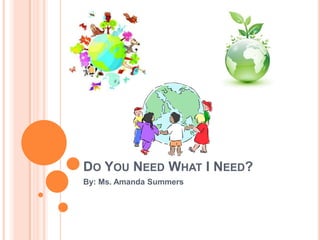
Do You Need What I Need?
- 1. Do You Need What I Need? By: Ms. Amanda Summers
- 2. Standard 3: The Living Environment Indicator 3.4.6- Explain that people need water, food, air, waste removal, and a particular range of temperatures, just as other animals do. Indiana’s Department of Education’s Website: http://dc.doe.in.gov/Standards/AcademicStandards/StandardSearch.aspx Link to Activity’s Website (Activity Modified for Class Purposes) http://www.indianastandardsresources.org/files/sci/sci_3_4_6.pdf
- 3. Definitions: Necessity- Conditions that cannot be changed; The quality or state of being in need. Necessary- Being required or needed. Essential- Important in the highest degree. Particular- of or relating to a single person or thing (in this case, temperatures). Sewage- Waste materials carried away by sewers (things that are flushed down the toilet or down your sink or bathtub drain) http://www.wordcentral.com/home.html
- 4. Background Information: All humans, plants, and animals have certain things they need to survive. You will be given a chart to help determine what these things are. Many things that we have in life are not necessities; they are to make life easier or more comfortable for us. All living things need food. Plants make their own food using sunlight, carbon dioxide from the air, and water. This process is called photosynthesis. Animals eat plants or other, smaller animals (many of these smaller animals eat plants). Humans eat plants or animals (these animals may eat other animals or plants)…in other words, it all leads back to plants.
- 5. Materials Required: Science Notebook Pencil Survival Chart Survival Game Pieces All items will be available in the Do You Need What I Need box provided by your USI instructor
- 6. Pre-Activity: Using the Survival Chart worksheet provided, list the following items in either the “Things People Need to Survive” or “Things People Do Not Need to Survive” columns: Food Video Games Shelter Books Jewelry Air Water Bed Car Waste Removal (Getting rid of trash or sewage) Sunlight Soap Safe Range of Temperatures TV Shoes
- 8. Things to Think About Before you Begin: **At the top of the page of your Science Notebook in the box, write your name, grade, and today’s date before answering questions. Please try to use complete sentences when you answer if possible.** Based on your chart, which items do we truly need to survive and which items do we have to make us comfortable or to enjoy? How do you know this? Why do you think waste removal is important? What would happen if all of the trash and sewage continued to build up around us? What about a safe range of temperatures? What would happen if it was hot as the sun or as cold as the North Pole? Would we be able to survive? Why or why not? Are there other items that humans truly need that is not included on this list? If so, what are they?
- 9. Survival Game Now that you have considered the chart of things that humans need to survive, you know that there are six items on that list that are essential to humans: food, water, shelter, air, waste removal, and safe range of temperatures. In the zip-lock bag provided, there are pieces of the items from your list (four of each item that you need and one of each item that just makes you comfortable). If you like, you could do the math to see how many pieces you have in the bag. You have four pieces of the six essential items (so 6 x 4) and one piece of the eleven items that are not needed (so 1 x 11). Once you get these results, you add those answers together. How many pieces are in the bag? Place the pieces upside down on your desk (or workspace). You can shake the bag to mix the pieces before you lay them on the floor. Once all pieces are laid out, you can draw six times since there are six things you need to survive. Did you draw all six things you need or some of the things that just make you comfortable? If you did not get all six things you need to survive, would you be able to survive without the things you did not draw? Why or why not? Game can be repeated as time allows. Game is based on activity on: http://www.indianastandardsresources.org/files/sci/sci_3_4_6.pdf
- 10. Here are Some Other Things to Think About: Think if you were an animal and not a human. Would you need the same things to survive? What things might a human need that an animal would not? A) House B) TV C) Exercise D) Variety of Foods Now think if you were a plant and not a human. Plants can make their own food using photosynthesis. What is something that a plant might need to survive that a human would not? A) Soil B) Sunlight C) Sleep/Rest D) Both A & B If you would like to further your research, pick a certain plant or animal (say a cactus or a cheetah). Using books or the internet, research what things it needs to survive. Are these the same things as humans? If other children use this box, you could share your findings with your classmates.
- 11. Congratulations!! You have completed the Do You Need What I Need? box! Hopefully you now have a better understanding of what living things need to survive and should be able to explain why they need these things!